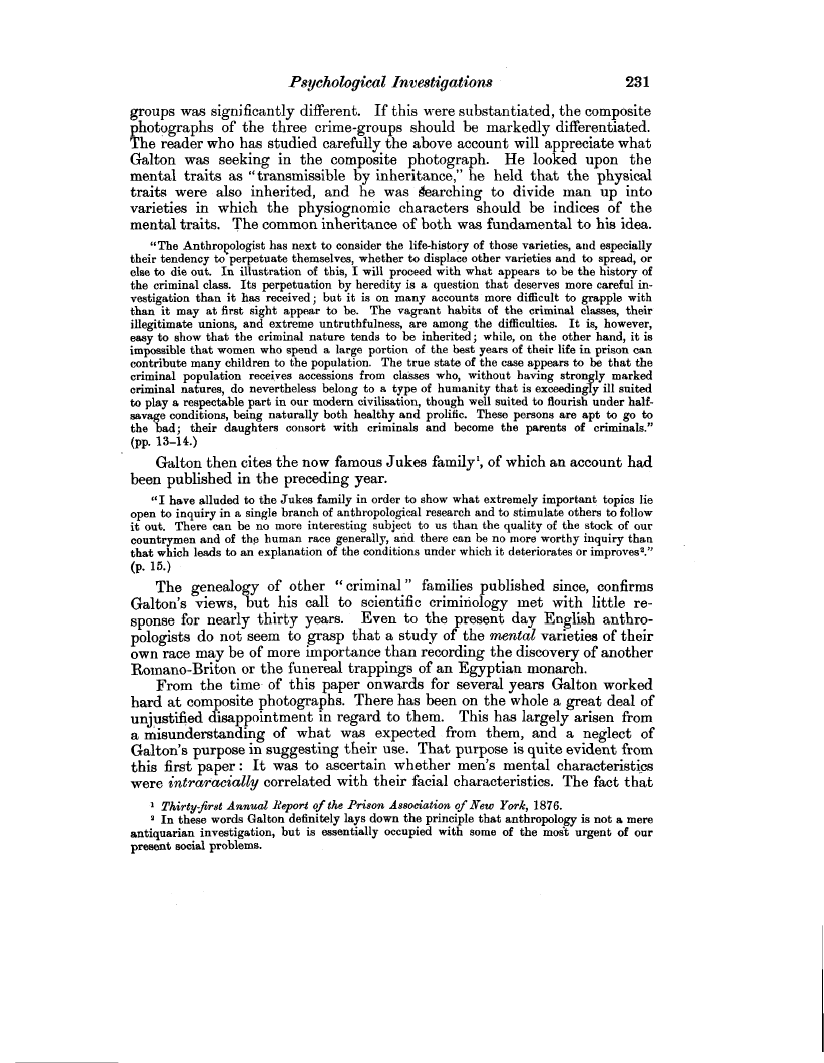Psychological Investigations 231
groups was significantly different. If this were substantiated, the composite photographs of the three crime-groups should be markedly differentiated. The reader who has studied carefully the above account will appreciate what Galton was seeking in the composite photograph. He looked upon the mental traits as "transmissible by inheritance," he held that the physical traits were also inherited, and he was gearching to divide man up into varieties in which the physiognomic characters should be indices of the mental traits. The common inheritance of both was fundamental to his idea.
"The Anthroeologist has next to consider the life-history of those varieties, and especially their tendency to perpetuate themselves, whether to displace other varieties and to spread, or else to die out. In illustration of this, I will proceed with what appears to be the history of the criminal class. Its perpetuation by heredity is a question that deserves more careful investigation than it has received; but it is on many accounts more difficult to grapple with than it may at first sight appear to be. The vagrant habits of the criminal classes, their illegitimate unions, and extreme untruthfulness, are among the difficulties. It is, however, easy to show that the criminal nature tends to be inherited; while, on the other hand, it is impossible that women who spend a large portion of the best years of their life in prison can contribute many children to the population. The true state of the case appears to be that the criminal population receives accessions from classes who, without having strongly marked criminal natures, do nevertheless belong to a type of humanity that is exceedingly ill suited to play a respectable part in our modern civilisation, though well suited to flourish under halfsavage conditions, being naturally both healthy and prolific. These persons are apt to go to the bad; their daughters consort with criminals and become the parents of criminals." (pp. 13-14.)
Galton then cites the now famous Jukes family', of which an account had been published in the preceding year.
"I have alluded to the Jukes family in order to show what extremely important topics lie open to inquiry in a single branch of anthropological research and to stimulate others to follow it out. There can be no more interesting subject to us than the quality of the stock of our countrymen and of the human race generally, and there can be no more worthy inquiry than that which leads to an explanation of the conditions under which it deteriorates or improves2." (p. 15.)
The genealogy of other " criminal " families published since, confirms Galton's views, but his call to scientific criminology met with little response for nearly thirty years. Even to the present day English anthropologists do not seem to grasp that a study of the mental varieties of their own race may be of more importance than recording the discovery of another Roinano-Briton or the funereal trappings of an Egyptian monarch.
From the time of this paper onwards for several years Galton worked hard at composite photographs. There has been on the whole a great deal of unjustified disappointment in regard to them. This has largely arisen from a misunderstanding of what was expected from them, and a neglect of Galton's purpose in suggesting their use. That purpose is quite evident from this first paper : It was to ascertain whether men's mental characteristics were intraracially correlated with their facial characteristics. The fact that
' Thirty-first Annual Report of the Prison Association of New York, 1876.
2 In these words Galton definitely lays down the principle that anthropology is not a mere antiquarian investigation, but is essentially occupied with some of the most urgent of our present social problems.

